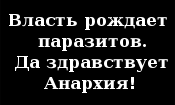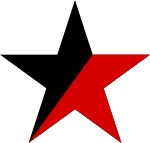Free Territory
| Free Territory Вільна територія | |||||||||||
|---|---|---|---|---|---|---|---|---|---|---|---|
| 1918–1921 | |||||||||||
 A flag used in the Free Territory as described by Viktor Belash
| |||||||||||
|
Motto: "Power begets parasites. Long live anarchy!" | |||||||||||
 Approximate location of the Free Territory (red) in present-day Ukraine (blue) | |||||||||||
| Status | Stateless territory | ||||||||||
| Capital | Huliaipole | ||||||||||
| Common languages |
Ukrainian Russian | ||||||||||
| Government | Autonomous anarchist confederation[1] | ||||||||||
| Military leader | |||||||||||
• 1919–1921 | Nestor Makhno | ||||||||||
| Historical era | Russian Civil War | ||||||||||
• Established | 1918 | ||||||||||
• Disestablished | 1921 | ||||||||||
| Population | |||||||||||
• Estimate | 7 million | ||||||||||
| |||||||||||
| Today part of | |||||||||||
The Free Territory (Ukrainian: Вільна територія vilna terytoriya; Russian: Вольная территория volnaya territoriya) or Makhnovia (Махновщина Makhnovshchyna) resulted from an attempt to form a stateless anarchist[1] society during the Ukrainian Revolution of 1917 to 1921. It existed from 1918 to 1921, during which time "free soviets" and libertarian communes[2] operated under the protection of Nestor Makhno's Revolutionary Insurrectionary Army. The area had a population of around seven million.[3]
Russian forces of the White movement under Anton Denikin occupied the territory and formed a temporary government of Southern Russia in March 1920, but in late March 1920 Denikin's forces retreated from the area, driven out by the Red Army in cooperation with Makhno's forces, whose units conducted guerrilla warfare behind Denikin's lines.
As the Free Territory self-organized along anarchist principles, references to "control" and "government" are highly contentious. For example, the Makhnovists, often cited as a form of government (with Nestor Makhno as their "leader"), played a purely military role, with Makhno himself functioning as little more than a military strategist and advisor.[4]
History
Development and characteristics
From November 1918 to June 1919, the Revolutionary Insurrectionary Army of Ukraine attempted to establish an anarchist society run by peasants and workers in Ukraine. The territory under their control stretched approximately between Berdyansk, Donetsk, Alexandrovsk (later known as Zaporizhia), and Yekaterinoslav, (Sicheslav, later Dnipropetrovsk, now Dnipro). According to Makhno, "The agricultural majority of these villages was composed of peasants, one would understand at the same time both peasants and workers. They were founded first of all on equality and solidarity of its members. Everyone, men and women, worked together with a perfect conscience that they should work on fields or that they should be used in housework... The work program was established in meetings in which everyone participated. Then they knew exactly what they had to do". (Makhno, Russian Revolution in Ukraine, 1936).
According to the leaders of the Revolutionary Insurrectionary Army of Ukraine (RIAU), society was reorganized according to anarchist values, which lead Makhnovists to formalize the policy of free communities as the highest form of social justice. Education followed the principles of Francesc Ferrer, and the economy was based on free exchange between rural and urban communities, from crops and cattle to manufactured products, according to the theories of Peter Kropotkin.
The Makhnovists said they supported "free worker-peasant soviets"[5] and opposed the central government. Makhno called the Bolsheviks "dictators" and opposed the "Cheka (secret police)... and similar compulsory authoritative and disciplinary institutions". He called for "freedom of speech, press, assembly, unions and the like".[5] The Makhnovists called various congresses of soviets, in which all political parties and groups – including Bolsheviks – were permitted to participate, to the extent that members of these parties were elected delegates from worker, peasant or militia councils. By contrast, in Bolshevik territory after June 1918, no non-Bolsheviks were permitted to participate in any national soviets and most local ones,[6] the decisions of which were also all subject to Bolshevik party veto.
A declaration stated that Makhnovist revolutionaries were forbidden to participate in the Cheka, and all party-run militias and party police forces (including Cheka-like secret police organizations) were to be outlawed in Makhnovist territory.[7][8] Historian Heather-Noël Schwartz comments that "Makhno would not countenance organizations that sought to impose political authority, and he accordingly dissolved the Bolshevik revolutionary committees".[9][10] The Bolsheviks, however, accused him of having two secret police forces operating under him.[11]
The Bolsheviks began their formal efforts to disempower Makhno on 4 June 1919 with Trotsky's Order No. 1824, which forbade electing a congress and attempted to discredit Makhno by stating: "The Makhno brigade has constantly retreated before the White Guards, owing to the incapacity, criminal tendencies, and the treachery of its leaders."[12]
Defeat
The Bolshevik government in Petrograd initially allied with Makhno and considered allowing an independent area for Makhno's libertarian experiment.[9] But the Bolsheviks increasingly saw the Makhnovists as a threat to their power, both as an example and as a site of anarchist influence.[13] It restarted a propaganda campaign declaring the Free Territory to be a region of warlords, and eventually broke with it by launching surprise attacks on Makhnovist militias[14] despite the pre-existing alliance between the factions.[15]
The Bolshevik press alleged that leaders in the Free Territory, rather than being democratically-elected, were appointed by Makhno's military clique. They also alleged that Makhno himself had refused to provide food for Soviet railwaymen and telegraph operators, that the "special section" of the Makhnovist constitution provided for secret executions and torture, that Makhno's forces had raided Red Army convoys for supplies, stolen an armored car from Bryansk when asked to repair it, and that the Nabat group was responsible for deadly acts of terrorism in Russian cities.[16]
Decisions
The Free Territory was a stateless and egalitarian society. Workers and peasants were organised into anarchist communities governed via a process of participatory democracy and were linked via an anarchist federation.[17]
When the Insurrectionary Army liberated a town from state control, it would post a notice clarifying they would not impose any authority on the town:
"Workers, your city is for the present occupied by the Revolutionary Insurrectionary (Makhnovist) Army. This army does not serve any political party, any power, any dictatorship. On the contrary, it seeks to free the region of all political power, of all dictatorship. It strives to protect the freedom of action, the free life of the workers, against all exploitation and domination. The Makhnovist Army does not therefore represent any authority. It will not subject anyone to any obligation whatsoever. Its role is confined to defending the freedom of the workers. The freedom of the peasants and the workers belongs to themselves, and should not suffer any restriction."[17]
Economy
The economy of Free Ukraine was a mixture of anarcho-communism and mutualism, with factories, farms and railways becoming cooperatives and several moneyless communities being created. The majority of territories continued to use money but planned to become anarcho-communist territories following the Russian Civil War.[17]
Education
The Free Territory abolished compulsory education and established several schools and adult education centres based off democratic education.[17]
Flags

In the Free Territory, multiple variations of black flags were used by the Revolutionary Insurrectionary Army and the free soviets, often with mottos written on them. Ukrainian anarchist Viktor Belash said in his memoirs that flags with slogans such as "Power generates parasites, Long live Anarchy!" and "All power to the soviets right now!" were used at the Gulyai-Polye district soviet and insurgent army headquarters. [18] A photo showing a flag with a death's head and the motto "Death to all those who stand in the way of the working people." is often attributed to Makhnovists, first in the Soviet book Jewish Pogroms 1917-1921, but this was denied by Nestor Makhno, who said the photo "does not show Makhnovists at all. The backside of this flag has words translating roughly to "Kish of Dnieper", the name Kish being used by military units of the Free Cossacks and the Ukrainian People's Republic.[19][20]
Criticism
The Free Territory has been criticised for alleged anti-semitic pogroms, banditry and sexual abuse of women within the Revolutionary Insurrectionary Army. Supporters of the Free Territory argue that some of these criticisms (such as anti-semitism) are outright fabrications, or have been significantly exaggerated by Leninists to discredit anti-authoritarian forms of socialism.[21]
See also
Notes
- 1 2 Noel-Schwartz, Heather.The Makhnovists & The Russian Revolution - Organization, Peasantry and Anarchism. Archived on Internet Archive. Accessed October 2010.
- ↑ Skirda, Alexandre, Nestor Makhno: Anarchy's Cossack. AK Press, 2004, p. 86
- ↑ Peter Marshall, Demanding the Impossible, PM Press (2010), p. 473.
- ↑ Skirda, Alexandre, Nestor Makhno: Anarchy's Cossack. AK Press, 2004, p. 34
- 1 2 Declaration Of The Revolutionary Insurgent Army Of The Ukraine (Makhnovist). Peter Arshinov, History of the Makhnovist Movement (1918-1921), 1923. Black & Red, 1974
- ↑ Simon Pirani, The Russian Revolution in Retreat, 1920–24: Soviet Workers and the New Communist Elite, Routledge, 2008, p. 96.
- ↑ Nestor Makhno--anarchy's Cossack
- ↑ Declaration Of The Revolutionary Insurgent Army Of The Ukraine (Makhnovist). Peter Arshinov, History of the Makhnovist Movement (1918-1921), 1923. Black & Red, 1974
- 1 2 Avrich, Paul. Anarchist Portraits, 1988, Princeton University Press, pp. 114, 121.
- ↑ Schwartz, Heather-Noël (January 7, 1920), The Makhnovists & The Russian Revolution: Organization, Peasantry, and Anarchism, archived from the original on January 18, 2008, retrieved January 18, 2008
- ↑ Footman, David. Civil War In Russia Frederick A.Praeger 1961, page 287
- ↑ Daniel Cohn-Bendit and Gabriel Cohn-Bendit, The Makhno Movement and Opposition Within the Party
- ↑ Skirda, Alexandre, Nestor Makhno: Anarchy's Cossack. AK Press, 2004, p. 236
- ↑ Skirda, Alexandre, Nestor Makhno: Anarchy's Cossack. AK Press, 2004, p. 238
- ↑ Skirda, Alexandre, Nestor Makhno: Anarchy's Cossack. AK Press, 2004, p. 237
- ↑ 'The Makhno Myth', International Socialist Review #53, May–June 2007.
- 1 2 3 4 Eikhenbaum, Vsevolod (1947). The Unknown Revolution, 1917 - 1921. Book Three. The Struggle For Real Social Revolution.
- ↑ Skirda, Alexandre (2003). Nestor Makhno, Anarchy's Cossack (4th ed.). AK Press. p. 86. ISBN 1 902593 68 5.
- ↑ Makhno, Nestor (April–May 1927). "To the Jews of all Countries". Delo Truda. Libcom.org: pgs. 8-10. Retrieved 9 October 2018.
By contrast, the same document does mention a number of pogroms and alongside prints the photographs of Makhnovist insurgents, though it is not clear what they are doing there, on the one hand, and which, in point of fact are no even Makhnovists, as witness the photograph purporting to show 'Makhnovists on the move' behind a black flag displaying a death's head: this is a photo that has no connection with pogroms and indeed and especially does not show Makhnovists at all.
- ↑ Los de Abajo a la Izquierda (9 December 2017). "Makhnovist flag or banner? Well, NO". Los de Abajo a la Izquierda. Blogspot. Retrieved 12 October 2018.
- ↑ An Anarchist FAQ. Appendix: The Russian Revolution
Bibliography
- Peter Arshinov, History of the Makhnovist Movement (1918-1921), 1923.
- Alexandre Skirda, Nestor Makhno: Anarchy's Cossack - The struggle for Free Soviets in the Ukraine 1917-1921. AK Press, 2004


